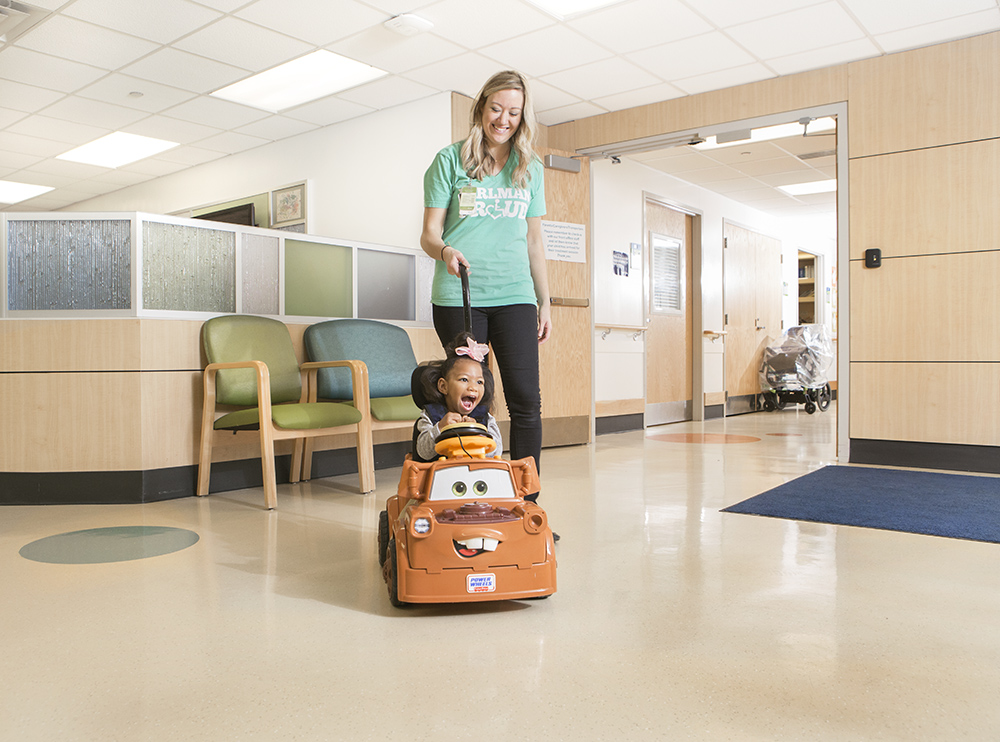
Photograph by Aaron M. Conway/OMS
For our January 2015 Top Doctors issue, we spoke with Molly Fugate, PT, DPT, Physical Therapist I at Cincinnati Children’s Hospital Medical Center’s Aaron W. Perlman Center about mobility for the city’s smallest patients:
“We treat children from birth to age 3 in our Early Intervention Program. A lot of our patients have cerebral palsy, some of them may have a developmental delay, spinal muscular atrophy, spina bifida. They’re not crawling, they’re not walking, they don’t have the muscle strength in their legs to use a gait trainer—an adaptive piece of equipment to help them stay upright and walk—or they can’t use their arms to propel a manual wheelchair. They don’t make independent power wheelchairs small enough for little tiny kids.
We met Dr. Cole Galloway, who is from the University of Delaware and has done research in the area of child mobility, at a national conference. We loved his GoBabyGo project—the idea of [converting] a typical toy such as a Barbie car for a child with special needs. We had Dr. Galloway and his team come to Cincinnati and we trained area therapists on how to build a car and the principles of early mobility.
These cars support [kids who are] age 12 months to 3 years, depending on size. They’re single passenger cars—a “Tow-Mater” car from the movie Cars—and they’re pretty small. There’s a Lightning McQueen car that might be a little bit bigger. We don’t really recommend a big Barbie Jeep or Hummer.
We have an evaluation just to make sure that they purchase the right size car so they can use it for as long as possible and not grow out of it, [but] we don’t do the modification work here. The Perlman Center has collaborated with May We Help, a local group of volunteers. A family buys the car anywhere—Toys “R” Us, online, or Target. It costs about $100. The car is then modified at no cost to the family. May We Help subsidizes the rest [the modification is about $150 for the parts]. It can take a couple of weeks.
They put a big round button on the steering wheel [and] adapt the route of the electronics so that when the kids hit the button, that makes it move, as opposed to a gas pedal or a button where you would have to use a finger. A lot of our patients can’t isolate a finger or use their thumbs to press small buttons, but they can use their whole arm or their whole hand to hit a larger button. We have switches that the child can use with their head if they are not able to use their hand.
The kids just make it stop and go; the parents have to actually turn it for them—there’s usually an attendant handlebar on the back. It definitely helps in the progression of building up to a power wheelchair; it gets those initial movement patterns needed to be more independent in a power chair later on in life. I believe we’ve done about 11 or 12 in a little over a year. Our goal this coming year is to have five to 10 in our fleet that we can hand out to families.
The GoBabyGo cars are good for preserving endurance. I think they give patients a really good sense of independence. It’s a good way to get out and do the same things that typical kids their age are doing—go to the playground, move around, chase your brother or sister. A “Mater Car” can allow a family to be a family, and interact in a playful way with their child.” —as told to Lisa Murtha






Facebook Comments